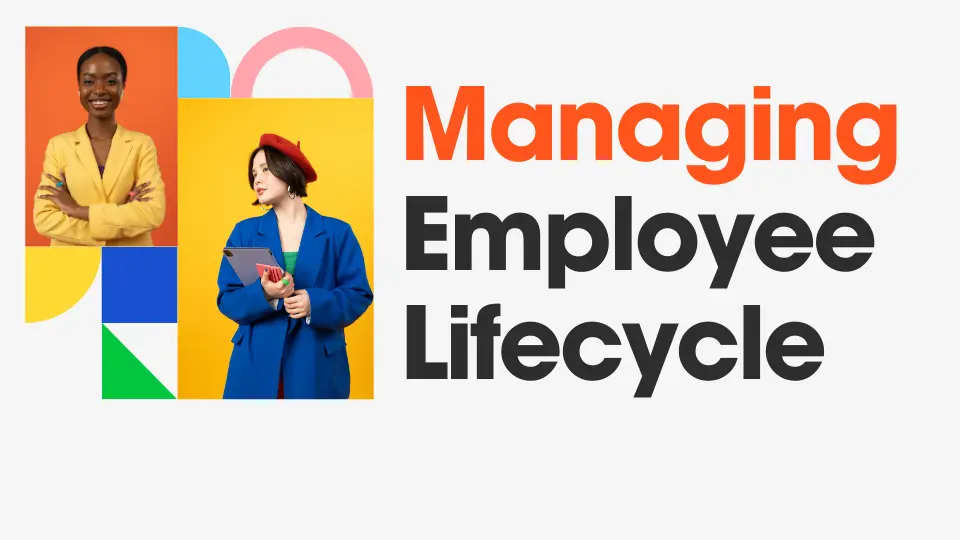

Employee Lifecycle: A Comprehensive Guide to Business Success
An employee’s journey within an organisation entails considerably more than just a string of duties and tasks. The “employee lifecycle” is a dynamic, complex experience.
This lifespan starts with the original hiring process and lasts far through the first day of work, covering a number of phases like onboarding, career advancement, and eventually, exit or retirement. Businesses aiming to attract, retain, and develop people in today’s cutthroat workplace must fully understand and manage the employee lifecycle.
We’ll explore each stage of the employee lifecycle and how it contributes to creating a productive and engaged staff as we delve into the complexities of the process in this blog. Let’s start now!
What Is Employee Lifecycle?
A tool used by organisations to visualise how employees interact with the business they work for is the employee life cycle model (ELC). This paradigm consists of the following six phases: Attraction, Recruitment, Onboarding, Development, Retention, and Separation.
A human resources model known as the employee lifecycle describes the various stages that a person progresses through within an organisation and the function that HR plays in maximising that progression. Employers can use this model to assess the interactions workers have with the organisation while they are working there in an effort to lower staff turnover and continuously raise employee satisfaction, productivity, and engagement.
The phrase, in essence, refers to a worker’s tenure at the organisation. Some phases of the employee lifecycle include employing talent management software and are overlapped with fundamental HR duties.
HR lifecycle or simply HR cycle are several names for the employee lifecycle. The phrase may also be referred to as the employee life cycle.
Fynzo Survey: Unlimited surveys, unlimited responses, majority of features are forever free.
Create a free survey with the easiest online survey creator.
What Are The 7 Stages Of Employee Lifecycle?
Seven stages make up the traditional employee life cycle model, which begins with enticing candidates and ends with an employee leaving.
To ensure the overall success of your business, it is crucial to complete each stage successfully. To do this, you must first understand what each stage entails in order to optimise it for maximum gain.
The seven steps are as follows:
1. Attraction
Employee attraction is the initial phase of the employee life cycle. No matter how good and innovative your product or service is, without the ability to draw in and keep top employees, your business will fail. As a result, one of the most important components of every organization’s growth plan is the attraction stage.
The only step that takes place before you have an open position with the company is the attraction stage. It is the projection of your company’s reputation as a fantastic place to work, both in the eyes of existing employees and important stakeholders in the external market. This concept is also known as the employer brand. This indicates that clients, customers, active and passive talent candidates, and potential stakeholders have a favourable impression of working with your business.
2. Recruitment

All the steps up to and including employing a new employee are included in this phase. Some businesses use talent acquisition software to plan and automate every step of the hiring process, including the usage of an applicant tracking system, pre-employment screening, scheduling interviews, and candidate follow-up. Recruiters can attract top talent and expedite the hiring process with the use of talent acquisition tools. The full employment cycle can be supported by HR solutions in the cloud.
3. Onboarding
Employee onboarding is the following stage in the employee life cycle model. The onboarding process, which comes after you have hired the best candidates, is crucial to ensuring that your new hires are as swiftly and smoothly acclimated to the organisational environment and performance components of their new position as possible.
New hires learn more about their positions in-depth during the onboarding process, as well as the attitudes, information, abilities, and behaviours needed to perform well within the company.
Drawing forth long-term contributions and engagement from new personnel requires that they feel welcomed into the group and well-acclimated to the nature of both their work and the organisation.
4. Employee Development

The employee’s professional growth is covered in this phase, along with the methods the company employs to provide feedback to workers, such as performance reviews and one-on-one check-ins.
The organisation may better understand what motivates employees and how well they’ve performed in comparison to their goals by receiving regular employee feedback, which is a crucial part of this stage. Regular feedback can increase staff engagement as well.
For more effective administration of employee activities, goal-setting, and timely feedback, many businesses use learning management systems or performance management software, which is occasionally included in a human capital management suite. In order to collect data that can enhance an employee’s performance, organisations frequently use personality profile tools.
5. Retention
The lifecycle model’s fifth stage is the one devoted to employee retention. Here is where you should concentrate your efforts on keeping your best workers, making sure they are content with and appropriately challenged by their positions within the team. The company culture has a significant impact at this point. If your company has a bad culture, there will definitely be a high rate of employee turnover, which means you will frequently have to pay for replacement staff. Enhancing the retention stage is a terrific strategy to reduce this risk and encourage longevity and happiness among the career paths on your team.
6. Offboarding
This happens when an employee quits their job, retires, is laid off, has a personal emergency, or is fired for breaking business rules. In any case, the offboarding process must be documented and follow the right protocols by the HR department.
Normally, HR will let the employee know their final compensation and perks. Offboarding is essential for assisting businesses in upholding a good corporate reputation and obtaining insightful feedback from departing employees. In turn, this information aids businesses in strengthening HR procedures and employee retention.
7. Advocacy
In a perfect world, every retiring employee would continue to actively represent the company as a result of the excellent employee experience throughout the whole lifespan.
Positive exit experiences increase a worker’s likelihood of recommending their company by almost three times compared to negative or indifferent experiences. Make sure departing workers feel acknowledged, appreciated, and proud of their efforts. Also, thank them for their service.
Fynzo Survey: Unlimited surveys, unlimited responses, majority of features are forever free.
Create a free survey with the easiest online survey creator.
Why Is The Employee Lifecycle Important?

Employees are the main reason behind the success of any business. So, it is really important to make sure that every stage of the employee lifecycle is done right. Employers are able to analyse data that might help them make improvements thanks to a lifecycle programme, which provides employees with a regular series of stages throughout their employment with the organisation. This can enhance an employee’s performance, longevity, and motivation.
Let’s have a look over some major points that are highlighting how important it is to make every stage of employee lifecycle done right.
1. Boosting Organisational Performance & Productivity
Understanding the various phases of your employee life cycle enables you to implement adjustments that will improve organisational performance and productivity. It assists you in determining the best methods for inspiring your staff, whether it be through rewards, educational opportunities, or other efforts.
In order to ensure that your staff members are at ease at all times, you can also find out what kind of environment they prefer to work in.
The fact that doing so can enhance income for organisations with exceptional employee experiences is a significant business justification. This is because happy and engaged employees are more effective and perform better.
2. Employee Retention
High employee turnover can be expensive and disruptive. Organisations can pinpoint and address causes like bad management, a lack of career possibilities, or stress at work by concentrating on the employee lifecycle.
Employee turnover can be generally decreased by continually enhancing the employee life cycle and experience because the current workforce will feel more engaged and valued. Additionally, it aids HR in predicting when workers are most likely to depart so that you may take measures to keep them before they go.
3. Cost Management
Managing the employee lifecycle effectively can aid in reducing costs associated with hiring, training, turnover, and other HR-related expenses. For instance, keeping experienced personnel on board can cost the company less money than frequently recruiting and onboarding new employees.
4. Employee Engagement
Employees that are engaged are more devoted, productive, and less inclined to leave the company. In order to increase engagement, managing the employee lifecycle entails techniques including rewarding achievement, creating a positive work environment, and responding to problems as soon as they arise.
5. Employee Development
Opportunities for development and progress are desired by employees. For employees to develop new abilities and grow within the organisation, training, mentoring, and career development programmes are included in the employee lifecycle.
All the above reasons are clearly stating how important it is to complete every employee lifecycle stage in a proper and right way.
Fynzo Survey: Unlimited surveys, unlimited responses, majority of features are forever free.
Create a free survey with the easiest online survey creator.
Who Manages Employee Life Cycle?

The management of the employment lifecycle requires collaboration across a variety of internal departments and people. Here are the main parties involved in managing the employee lifecycle, however precise duties may change depending on the size, structure, and culture of the organisation:
1. Human Resource Department
Managing the employment lifetime is often a top priority for HR. HR specialists are in charge of several phases, including hiring, onboarding, performance evaluation, training, and offboarding. They develop policies and procedures, guarantee adherence to labour laws and regulations, and offer direction to managers and staff.
2. Management
The employment lifetime is crucially influenced by frontline managers and supervisors. They are in charge of having daily encounters with staff members, establishing performance standards, giving feedback, and assisting in the growth of personnel. The retention and engagement of employees are substantially influenced by effective management at this level.
3. Employee Engagement Teams
For assessing and enhancing employee engagement, several organisations establish specific teams or employees. They carry out surveys, get input, and put measures into place to raise employee commitment and satisfaction.
4. Employee Assistance Programs (EAPs)
EAPs, or employee assistance programmes
EAPs may be present in larger organisations to support staff members who are coping with personal or professional challenges that may have an influence on their performance and well-being.
5. Employees
Employees are responsible for managing their own lifecycles inside the company. They are in charge of their own professional growth, including setting objectives, looking for possibilities for advancement, and actively engaging in performance reviews.
Having an employee lifecycle management programme will enable you to gather feedback at each stage and analyse it as a whole data set. This enables you to visualise the employee journey from hiring to termination and pinpoint the connections between the various tasks performed at each stage.
Fynzo Survey: Unlimited surveys, unlimited responses, majority of features are forever free.
Create a free survey with the easiest online survey creator.
How Can The KPIs Be Made Better At Each Stage?
Despite the fact that each stage has its own KPIs, they are all interconnected and affect KPIs in both the same and distinct phases of the life cycle.
Consider ramp time as an example; a shorter ramp time would not only affect production obviously, but also engagement. Similarly, it has been demonstrated that raising employee engagement would lower attrition and boost productivity.
Underestimating the impact of these KPIs on the organisation’s primary operational indicators can result from viewing them in isolation. HR professionals may, however, begin to understand the combined impact of changes across the lifecycle and pinpoint which activities will have the greatest overall impact on the organisation when evaluated as a whole data set.
In general, if it matters to your employees, it’s an excellent chance to gather feedback. However, while there are best practices templates for all forms of employee feedback, there are no hard and fast rules on when to gather input.
Summary
An important part of the HR job is to optimise the employment lifetime. To keep a solid, effective team, you can use this method to find excellent personnel and develop a retention strategy.
You can start using the employee life cycle model in your workplace now that you have a solid understanding of it. It’s crucial to keep in mind that the employee life cycle is dynamic and always evolving.
These suggestions can help you build a productive workplace that will keep your staff content, productive, and engaged, even if you find that you need to make adjustments along the way. Start putting these tactics into practice right away and see how your company will benefit greatly from them.
FAQs
Question 1- Why Is The Employee Life Cycle Important?
Answer- You can improve every stage and create a better employee experience once you understand the employee life cycle and each stage your (potential) employees go through. This can lead to increased production and improved overall results for your company.
Question 2- What Are The Stages Of The Employee Life Cycle?
Answer- Seven stages make up the employee life cycle: attraction, recruitment, onboarding, retention, development, offboarding, and happy departing employees. Every stage has distinct aims and targets. You can only deliver a comprehensive employee experience and accomplish your organisational goals by meeting them.









